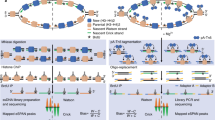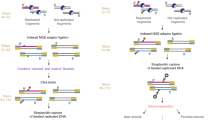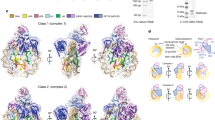Abstract
To maintain genome function and stability, DNA sequence and its organization into chromatin must be duplicated during cell division. Understanding how entire chromosomes are copied remains a major challenge. Here, we use nascent chromatin capture (NCC) to profile chromatin proteome dynamics during replication in human cells. NCC relies on biotin–dUTP labelling of replicating DNA, affinity purification and quantitative proteomics. Comparing nascent chromatin with mature post-replicative chromatin, we provide association dynamics for 3,995 proteins. The replication machinery and 485 chromatin factors such as CAF-1, DNMT1 and SUV39h1 are enriched in nascent chromatin, whereas 170 factors including histone H1, DNMT3, MBD1-3 and PRC1 show delayed association. This correlates with H4K5K12diAc removal and H3K9me1 accumulation, whereas H3K27me3 and H3K9me3 remain unchanged. Finally, we combine NCC enrichment with experimentally derived chromatin probabilities to predict a function in nascent chromatin for 93 uncharacterized proteins, and identify FAM111A as a replication factor required for PCNA loading. Together, this provides an extensive resource to understand genome and epigenome maintenance.
This is a preview of subscription content, access via your institution
Access options
Subscribe to this journal
Receive 12 print issues and online access
$209.00 per year
only $17.42 per issue
Buy this article
- Purchase on Springer Link
- Instant access to full article PDF
Prices may be subject to local taxes which are calculated during checkout








Similar content being viewed by others
References
Mechali, M. Eukaryotic DNA replication origins: many choices for appropriate answers. Nat. Rev. Mol. Cell Biol. 11, 728–738 (2010).
Alabert, C. & Groth, A. Chromatin replication and epigenome maintenance. Nat. Rev. Mol. Cell Biol. 13, 153–167 (2012).
Margueron, R. & Reinberg, D. Chromatin structure and the inheritance of epigenetic information. Nat. Rev. Genet. 11, 285–296 (2010).
Baylin, S. B. & Jones, P. A. A decade of exploring the cancer epigenome - biological and translational implications. Nat. Rev. Cancer 11, 726–734 (2011).
Worcel, A., Han, S. & Wong, M. L. Assembly of newly replicated chromatin. Cell 15, 969–977 (1978).
Annunziato, A. T. & Seale, R. L. Histone deacetylation is required for the maturation of newly replicated chromatin. J. Biol. Chem. 258, 12675–12684 (1983).
DePamphilis, M. L. & Wassarman, P. M. Replication of eukaryotic chromosomes: a close-up of the replication fork. Annu. Rev. Biochem. 49, 627–666 (1980).
Annunziato, A. T. Assembling chromatin: The long and winding road. Biochim. Biophys. Acta 1819, 196–210 (2012).
Sobel, R. E., Cook, R. G., Perry, C. A., Annunziato, A. T. & Allis, C. D. Conservation of deposition-related acetylation sites in newly synthesized histones H3 and H4. Proc. Natl Acad. Sci. USA 92, 1237–1241 (1995).
Sirbu, B. M. et al. Analysis of protein dynamics at active, stalled, and collapsed replication forks. Genes Dev. 25, 1320–1327 (2011).
Taddei, A., Roche, D., Sibarita, J. B., Turner, B. M. & Almouzni, G. Duplication and maintenance of heterochromatin domains. J. Cell Biol. 147, 1153–1166 (1999).
Dejardin, J. & Kingston, R. E. Purification of proteins associated with specific genomic Loci. Cell 136, 175–186 (2009).
Ohta, S. et al. The protein composition of mitotic chromosomes determined using multiclassifier combinatorial proteomics. Cell 142, 810–821 (2010).
Maya-Mendoza, A., Olivares-Chauvet, P., Kohlmeier, F. & Jackson, D. A. Visualising chromosomal replication sites and replicons in mammalian cells. Methods 2, 140–148 (2012).
Koberna, K. et al. Nuclear organization studied with the help of a hypotonic shift: its use permits hydrophilic molecules to enter into living cells. Chromosoma 108, 325–335 (1999).
Ong, S. E. et al. Stable isotope labeling by amino acids in cell culture, SILAC, as a simple and accurate approach to expression proteomics. Mol. Cell Proteom. 1, 376–386 (2002).
Maser, R. S. et al. Mre11 complex and DNA replication: linkage to E2F and sites of DNA synthesis. Mol. Cell Biol. 21, 6006–6016 (2001).
Betous, R. et al. SMARCAL1 catalyzes fork regression and Holliday junction migration to maintain genome stability during DNA replication. Genes Dev. 26, 151–162 (2012).
Duro, E. et al. Identification of the MMS22L-TONSL complex that promotes homologous recombination. Mol. Cell 40, 632–644 (2010).
Bubeck, D. et al. PCNA directs type 2 RNase H activity on DNA replication and repair substrates. Nucl. Acids Res. 39, 3652–3666 (2011).
Nielsen, F. C., Jager, A. C., Lutzen, A., Bundgaard, J. R. & Rasmussen, L. J. Characterization of human exonuclease 1 in complex with mismatch repair proteins, subcellular localization and association with PCNA. Oncogene 23, 1457–1468 (2004).
Li, G. M. Mechanisms and functions of DNA mismatch repair. Cell Res. 18, 85–98 (2008).
Moldovan, G. L., Pfander, B. & Jentsch, S. PCNA, the maestro of the replication fork. Cell 129, 665–679 (2007).
Groth, A. et al. Regulation of replication fork progression through histone supply and demand. Science 318, 1928–1931 (2007).
Jasencakova, Z. et al. Replication stress interferes with histone recycling and predeposition marking of new histones. Mol. Cell 37, 736–743 (2010).
Albert, M. & Helin, K. Histone methyltransferases in cancer. Semin. Cell Dev. Biol. 21, 209–220 (2010).
Scharf, A. N., Barth, T. K. & Imhof, A. Establishment of histone modifications after chromatin assembly. Nucl. Acids Res. 37, 5032–5040 (2009).
Xu, M., Wang, W., Chen, S. & Zhu, B. A model for mitotic inheritance of histone lysine methylation. EMBO Rep. 13, 60–67 (2011).
Kustatscher, G. et al. Proteomics of a fuzzy organelle: interphase chromatin. EMBO J.http://dx.doi.org/10.1002/embj.201387614 (in the press)
Fridman, Y. et al. Subtle alterations in PCNA-partner interactions severely impair DNA replication and repair. PLoS Biol. 8, e1000507 (2010).
Li, R., Waga, S., Hannon, G. J., Beach, D. & Stillman, B. Differential effects by the p21 CDK inhibitor on PCNA-dependent DNA replication and repair. Nature 371, 534–537 (1994).
Warbrick, E., Lane, D. P., Glover, D. M. & Cox, L. S. A small peptide inhibitor of DNA replication defines the site of interaction between the cyclin-dependent kinase inhibitor p21WAF1 and proliferating cell nuclear antigen. Curr. Biol. 5, 275–282 (1995).
Masata, M., Juda, P., Raska, O., Cardoso, M. C. & Raska, I. A fraction of MCM 2 proteins remain associated with replication foci during a major part of S phase. Folia Biol. 57, 3–11 (2011).
Sirbu, B. M., Couch, F. B. & Cortez, D. Monitoring the spatiotemporal dynamics of proteins at replication forks and in assembled chromatin using isolation of proteins on nascent DNA. Nat. Protoc. 7, 594–605 (2012).
Kliszczak, A. E., Rainey, M. D., Harhen, B., Boisvert, F. M. & Santocanale, C. DNA mediated chromatin pull-down for the study of chromatin replication. Sci. Rep. 1, 95 (2011).
Fine, D. A. et al. Identification of FAM111A as an SV40 host range restriction and adenovirus helper factor. PLoS Pathog. 8, e1002949 (2012).
Akamatsu, S. et al. Common variants at 11q12, 10q26 and 3p11.2 are associated with prostate cancer susceptibility in Japanese. Nat. Genet. 44, 426–429 (2012).
Perry, C. A. & Annunziato, A. T. Histone acetylation reduces H1-mediated nucleosome interactions during chromatin assembly. Exp. Cell Res. 196, 337–345 (1991).
Francis, N. J., Kingston, R. E. & Woodcock, C. L. Chromatin compaction by a polycomb group protein complex. Science 306, 1574–1577 (2004).
Francis, N. J., Follmer, N. E., Simon, M. D., Aghia, G. & Butler, J. D. Polycomb proteins remain bound to chromatin and DNA during DNA replication in vitro. Cell 137, 110–122 (2009).
Hansen, K. H. et al. A model for transmission of the H3K27me3 epigenetic mark. Nat. Cell Biol. 10, 1291–1300 (2008).
Margueron, R. et al. Role of the polycomb protein EED in the propagation of repressive histone marks. Nature 461, 762–767 (2009).
Boyarchuk, E., Montes de Oca, R. & Almouzni, G. Cell cycle dynamics of histone variants at the centromere, a model for chromosomal landmarks. Curr. Opin. Cell Biol. 23, 266–276 (2011).
Jansen, L. E., Black, B. E., Foltz, D. R. & Cleveland, D. W. Propagation of centromeric chromatin requires exit from mitosis. J. Cell Biol. 176, 795–805 (2007).
Zeitlin, S. G. et al. Double-strand DNA breaks recruit the centromeric histone CENP-A. Proc. Natl Acad. Sci. USA 106, 15762–15767 (2009).
Bui, M. et al. Cell-cycle-dependent structural transitions in the human CENP-A nucleosome in vivo. Cell 150, 317–326 (2012).
Nekrasov, M. et al. Histone H2A.Z inheritance during the cell cycle and its impact on promoter organization and dynamics. Nat. Struct. Mol. Biol. 19, 1076–1083 (2012).
Sariban, E., Wu, R. S., Erickson, L. C. & Bonner, W. M. Interrelationships of protein and DNA syntheses during replication of mammalian cells. Mol. Cell Biol. 5, 1279–1286 (1985).
Petruk, S. et al. TrxG and PcG proteins but not methylated histones remain associated with DNA through replication. Cell 150, 922–933 (2012).
Dimitrova, D. S., Todorov, I. T., Melendy, T. & Gilbert, D. M. Mcm2, but not RPA, is a component of the mammalian early G1-phase prereplication complex. J. Cell Biol. 146, 709–722 (1999).
Cox, J. & Mann, M. MaxQuant enables high peptide identification rates, individualized p.p.b.-range mass accuracies and proteome-wide protein quantification. Nat. Biotechnol. 26, 1367–1372 (2008).
Shevchenko, A., Tomas, H., Havlis, J., Olsen, J. V. & Mann, M. In-gel digestion for mass spectrometric characterization of proteins and proteomes. Nat. Protoc. 1, 2856–2860 (2006).
Rappsilber, J., Ishihama, Y. & Mann, M. Stop and go extraction tips for matrix-assisted laser desorption/ionization, nanoelectrospray, and LC/MS sample pretreatment in proteomics. Anal. Chem. 75, 663–670 (2003).
Marzluff, W. F., Gongidi, P., Woods, K. R., Jin, J. & Maltais, L. J. The human and mouse replication-dependent histone genes. Genomics 80, 487–498 (2002).
Green, C. M. & Almouzni, G. Local action of the chromatin assembly factor CAF-1 at sites of nucleotide excision repair in vivo. EMBO J. 22, 5163–5174 (2003).
Chon, H. et al. Contributions of the two accessory subunits, RNASEH2B and RNASEH2C, to the activity and properties of the human RNase H2 complex. Nucl. Acids Res. 37, 96–110 (2009).
Gilljam, K. M. et al. Identification of a novel, widespread, and functionally important PCNA-binding motif. J. Cell Biol. 186, 645–654 (2009).
Acknowledgements
We would like to thank J. Déjardin for fruitful discussions, K. Helin for reagents (Biotech Research and Innovation Centre and Centre for Epigenetics, University of Copenhagen, Denmark), Ib J. Christensen for support on statistics, and C. Wu, W. C. Earnshaw and Z. Jasencakova for critical reading of this manuscript. The A.G. laboratory is supported by a European Research Council Starting Grant (ERC2011StG, no. 281,765), the Lundbeck Foundation, the Danish Cancer Society, the Danish National Research Foundation (DNRF82) and Medical Research Council, the Novo Nordisk Foundation and FP7 Marie Curie Actions ITN Nucleosome4D. The Wellcome Trust generously supported this work through a Senior Research Fellowship to J.R. (084229), two Wellcome Trust Centre Core Grants (077707, 092076) and an instrument grant (091020). C.A. was supported by fellowships from HFSP and the Danish Medical Research Council. G.K. was supported by a FEBS Long-Term fellowship.
Author information
Authors and Affiliations
Contributions
A.G., C.A. and J.R. conceived the project and designed the study. C.A., S.L., K.N. and J.M. performed and analysed experiments. J.B., G.K., F.A. and J.R. performed mass spectrometry and analysed SILAC data. P.M. generated F.A.M. mutants. The manuscript was written by C.A. and A.G. and edited by J.R., J.B. and G.K.
Corresponding authors
Ethics declarations
Competing interests
The authors declare no competing financial interests.
Integrated supplementary information
Supplementary Figure 1
(a) Biotin-dUTP labelling does not affect S phase progression. Cells synchronized in mid-S phase were labelled with biotin-dUTP during a 5 min hypotonic shift (red) or incubated in PBS (blue), and analysed by FACS at the indicated times. (b) Biotin-dUTP labelling does not trigger DNA damage as measured by γ H2AX staining. Cells were treated with hydroxyurea (HU, 3 mM) for one hour as a positive control. (c) Co-localization between PCNA and biotin-dUTP is lost during chromatin maturation. U-2-OS cells stably expressing PCNA-RFP were pulse labelled with biotin-dUTP for 20 min and fixed directly (nascent) or left for 2 h before fixation (mature). Cells not treated with biotin-dUTP are shown as a negative control. (d, e) NCC with shorter biotin-dUTP labelling times. (d) The percentage of biotin-dUTP positive cells (left) and the biotin-dUTP intensity per cell (right) after 5, 10, 20 and 40 min of labelling. Horizontal lines represent the median, ****p < 0.0001, p=0.0168, n.s. p= 0.2918 (unpaired t test, 108 < n). Statistics source data is available in Supplementary Table 4. (e) Western blot analysis of NCC pull-downs after 5 and 10 min pulse-labelling with biotin-dUTP. Labelling times of > 5 min are preferable for efficient incorporation of biotin-dUTP. The amount of starting material should always be adjusted according to labelling time in order to achieve sufficient material for a comprehensive proteomic analysis.
Supplementary Figure 2
(a) Experimental design for NCC-SILAC. Two independent cultures grown in heavy and light amino acids were released into S phase from a single thymidine block. Cells were labelled with biotin-dUTP for 20 min 3 h after release into S phase. Light cultures were left to progress in S phase for 2 h after labelling, while heavy cultures were harvested immediately. Synchronization and release of heavy cultures were shifted 2 h with respect to light cultures, such that they could be cross-linked and processed in parallel for NCC. After pull-down, the heavy and light samples were washed stringently and mixed prior to SDS-PAGE and mass spectrometry. (b) Biotin-dUTP incorporation scored by immunofluorescence verified equal labelling efficiency in heavy and light cultures. Approximately 250 cells were counted. (c) Cell cycle profile of heavy and light cultures verified matching synchronization at the time of the labelling (left) and that light cultures had progressed to late S phase at the time of harvest (right). (d) Scatter-plot comparing log2 SILAC ratios between replicates and (e) histogram of median of pairwise log2 fold difference of SILAC ratios between three replicates, illustrating reproducibility of the NCC-SILAC technology.
Supplementary Figure 3
(a) Nascent chromatin enrichment of factors proposed to deal with DNA–RNA duplexes and protein degradation at the fork20,56. (b) Nascent chromatin enrichment of origin recognition and licensing factors. (c) Coverage of the PCNA interactome by NCC-SILAC. Bars illustrate factors identified in NCC relative to those reported in the literature, numbers are indicated in brackets. Functional groups of PCNA interactors are according to Moldovan et al., 2007. For details see Supplementary Table 2. (d) Analysis of factors enriched on nascent chromatin by western blot. For comparison the log2 nascent chromatin enrichment is indicated. (e) Nascent chromatin enrichment of lysine and arginine methyltransferases (violet) and demethylases (grey). (f) Nascent chromatin enrichment of RNA polymerases. Only unique subunits are shown. All Nascent chromatin enrichments are presented as in Fig. 1h.
Supplementary Figure 4
Box plot of nascent chromatin enrichment of the individual classes defined in Figure 5a.
Supplementary Figure 5
Analysis of GFP- or FLAG-tagged proteins in U-2-OS cells stably expressing RFP-PCNA. Localization pattern (a, c) and co-localization with PCNA measured by Pearson coefficient (b, d) were scored after pre-extraction. The Pearson coefficient is calculated for individual nuclei and shown in a box plot (n ≥ 9). Horizontal line represents the median.
Supplementary Figure 6
Uncropped Western blots.
Supplementary information
Supplementary Information
Supplementary Information (PDF 1759 kb)
Supplementary Table 1
Supplementary Information (XLSX 1182 kb)
Supplementary Table 2
Supplementary Information (XLSX 38 kb)
Supplementary Table 3
Supplementary Information (XLSX 177 kb)
Supplementary Table 4
Supplementary Information (XLSX 147 kb)
Rights and permissions
About this article
Cite this article
Alabert, C., Bukowski-Wills, JC., Lee, SB. et al. Nascent chromatin capture proteomics determines chromatin dynamics during DNA replication and identifies unknown fork components. Nat Cell Biol 16, 281–291 (2014). https://doi.org/10.1038/ncb2918
Received:
Accepted:
Published:
Issue Date:
DOI: https://doi.org/10.1038/ncb2918
This article is cited by
-
Dimerization-dependent serine protease activity of FAM111A prevents replication fork stalling at topoisomerase 1 cleavage complexes
Nature Communications (2024)
-
ZNF827 is a single-stranded DNA binding protein that regulates the ATR-CHK1 DNA damage response pathway
Nature Communications (2024)
-
Asymmetric distribution of parental H3K9me3 in S phase silences L1 elements
Nature (2023)
-
FAM111A is dispensable for electrolyte homeostasis in mice
Scientific Reports (2022)
-
Identification of replication fork-associated proteins in Drosophila embryos and cultured cells using iPOND coupled to quantitative mass spectrometry
Scientific Reports (2022)



